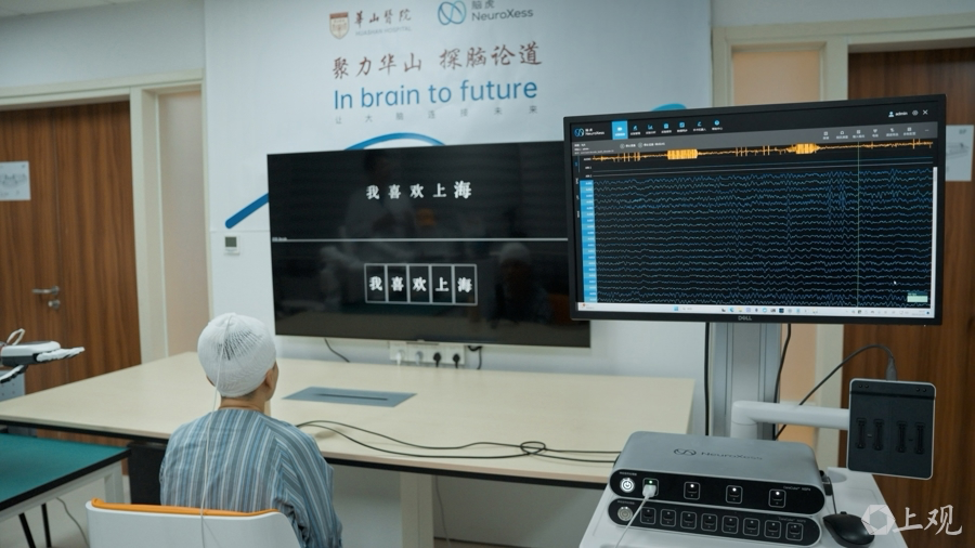
Scientists in Shanghai have achieved a major medical advance through collaboration between the YanSi Neuromorphic AI Institute and Huashan Hospital. In recent clinical tests, ten epilepsy (癫痫) patients with special brain devices learned to produce Chinese words simply by thinking after minimal training. This breakthrough offers new hope for people who have lost speech due to conditions like ALS or stroke. Brain-computer interface (BCI) technology enables direct communication between the brain and machines, holding great promise for healthcare, rehabilitation, and education. Shanghai has led China’s BCI development by building strong connections across research, industry, and medical fields.
Professor Mao Ying, director of Huashan Hospital, explained that with government support, they created a high-quality brain signal database using years of medical experience. The hospital also established the iBrain Data Alliance with other top neurosurgery hospitals. Partner institutions like YanSi access this shared data to develop BCI tools. “Using the world’s largest dataset of human brain signals, we built an advanced deep learning-based AI model that can read thoughts from brainwave patterns,” stated Professor Li Meng, YanSi’s chief scientist.
Understanding Chinese through brain signals presents special challenges. While English uses about 50 basic sounds, Chinese requires recognizing over 400 sound combinations. YanSi’s technology for reading signals from different brain areas, combined with their extensive database, solved this problem. During testing, epilepsy patients with existing sEEG devices spent 100 minutes reading 54 Chinese characters aloud. First, the devices recorded their brain activity from various locations. Then, the AI model broke down characters into sound components and matched them to brain patterns. Finally, it created personalized systems that build words from sounds to complete sentences.
Remarkably, after learning just 54 characters, the system understood 1,951 common Chinese words — demonstrating strong learning ability. It generates full sentences in under 0.5 seconds without length limits. “This transforms thoughts into text accurately and quickly,” Professor Li emphasized. Beyond helping speechless patients communicate, this technology may eventually allow mind-controlled devices, interaction with virtual worlds, or turning thoughts into AI artwork.
原创编写 版权所有 侵权必究! 每日更新 个性化阅读 英语飙升!
1.1.Who might benefit most from the new research achievement?
A People with a quiet personality.
B ALS or stroke patients.
C People with hearing problems.
D Those needing language practice.
解析:选B。B 细节理解题。第一段明确提到“This breakthrough offers new hope for people who have lost speech due to conditions like ALS or stroke.”,即因ALS或中风失去语言能力的人会受益。故选B。
2.2.What does the “thought-to-speech” success show?
A Advanced AI alone works.
B Teamwork across organizations.
C Hospital’s research dominance.
D Private company’s key role.
解析:选B。B 推理判断题。文章开头提到该成果是“collaboration between the YanSi Neuromorphic AI Institute and Huashan Hospital”,第二段提到“government support”“the iBrain Data Alliance”“Partner institutions”可知,这一成功体现了跨机构合作。故选B。
3.3.Why does understanding Chinese much tougher than English?
A Chinese has more basic sounds.
B English has more characters.
C Chinese needs more sound combinations.
D English is simpler to write.
解析:选C。C 细节理解题。第三段指出“While English uses about 50 basic sounds, Chinese requires recognizing over 400 sound combinations.”,说明理解中文更难是因为中文需要识别更多的语音组合。故选C。
4.4.What do the statistics in the last paragraph highlight about the system?
A Processing speed.
B Character limitations.
C Training efficiency.
D Learning capability.
解析:选D。D 推理判断题。最后一段存在两处与数据相关的内容:“after learning just 54 characters, the system understood 1,951 common Chinese words”和“generates full sentences in under 0.5 seconds”。题干问的是这些统计数据整体所突出的系统核心方面。“after learning just 54 characters, the system understood 1,951 common Chinese words”重点体现的是系统从少量学习内容中掌握大量知识的能力,即学习能力,这是该技术的核心突破之一,D项正确。“generates full sentences in under 0.5 seconds”,这确实是统计数据,但它只是系统的一个功能表现,而非整体统计数据所突出的核心能力(以偏概全)。故选D。
